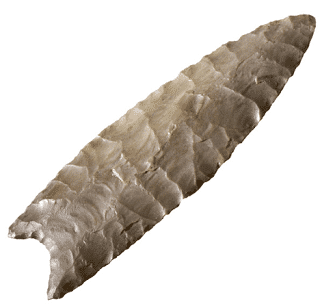You are using an out of date browser. It may not display this or other websites correctly.
You should upgrade or use an alternative browser.
You should upgrade or use an alternative browser.
Teaser
- Thread starter uniface
- Start date
MAMucker
Bronze Member
I’ll start,
This particular object dates to around 11,000 BCE, and was found in Arizona. This Blade is made of stone and measures 8.5 cm long and 3 cm across with a diameter of 0.7 cm.
This particular object dates to around 11,000 BCE, and was found in Arizona. This Blade is made of stone and measures 8.5 cm long and 3 cm across with a diameter of 0.7 cm.
Charl
Silver Member
I agree with MAMucker, and would add that it's classified as a Clovis by The British Museum, where it's on display in the North American gallery.
uniface
Silver Member
- Thread starter
- #4
Game over ! 
It was used as an illustration (improperly and deceptively) in this article
http://atlanteangardens.blogspot.com/2014/03/19000-year-old-virginia-flint-knife.html

It was used as an illustration (improperly and deceptively) in this article
http://atlanteangardens.blogspot.com/2014/03/19000-year-old-virginia-flint-knife.html
Last edited:
newnan man
Gold Member
Man that was a quick ID. Is it a Clovis?
Quartzite Keith
Full Member
- Dec 17, 2018
- 179
- 405
- Primary Interest:
- All Treasure Hunting
The Virginia biface the article references was found at the Browning Farm Site (44CC8) in Charles City County, along the James River during an excavation of an early colonial house. It was found in "Feature 4", described as "the lower portion of a clay chimney base with evidence of corner posts used to support a superstructure of catted clay and straw wattles." Various European early colonial artifacts of metal, glass, porcelain, earthen wear and gunflints were found in association. The only other Native American artifacts found in that feature were pottery sherds.
The biface is described as, "two halves of a restorable laurel leaf blade made from honey colored (French?) flint. This blade is identical to those typical of the Solutrean Culture of around 20,000 BC in France and Spain. The blade is 10.54 cm long and 3.5 cm wide, with a thickness of 7.5 mm. Its outer surface is patinated with a thick layer of corrosion products. It had been broken before burial, since two small wedge shaped slivers of the stone are missing, and the two larger pieces were physically separated about 2 feet when found."
I was unaware it was tested and determined to be of French flint. If any one has a reference for that, I would be interested in seeing it. Sorry no picture, all I have is a poor copy of a black and white photo, but I imagine with some looking someone smarter than me can find it online.
The biface is described as, "two halves of a restorable laurel leaf blade made from honey colored (French?) flint. This blade is identical to those typical of the Solutrean Culture of around 20,000 BC in France and Spain. The blade is 10.54 cm long and 3.5 cm wide, with a thickness of 7.5 mm. Its outer surface is patinated with a thick layer of corrosion products. It had been broken before burial, since two small wedge shaped slivers of the stone are missing, and the two larger pieces were physically separated about 2 feet when found."
I was unaware it was tested and determined to be of French flint. If any one has a reference for that, I would be interested in seeing it. Sorry no picture, all I have is a poor copy of a black and white photo, but I imagine with some looking someone smarter than me can find it online.
Charl
Silver Member
There were two bipoint blades found in the Delmarva, that were believed to be made of French flint. One is the one found beneath the colonial chimney. Another was found elsewhere, but I've lost track of the info at the moment, somewhere in my files. Joshuaream attended the conference in New Mexico a number of years ago, that discussed pre-Clovis, and he had color photos of the broken one. I have his photos bookmarked from a thread in another forum, and I'm not going to post his photos otherwise, but perhaps he'll see this thread and post them.
I found the info on the point uni posted by using the "search Google for similar images" function. I think it's the very first time that tool has actually helped me in a search, lol...
I found the info on the point uni posted by using the "search Google for similar images" function. I think it's the very first time that tool has actually helped me in a search, lol...
Hillbilly Prince
Silver Member
- Aug 9, 2018
- 4,999
- 12,712
- Detector(s) used
- Garrett All Terrain Pro
- Primary Interest:
- All Treasure Hunting
The Virginia biface the article references was found at the Browning Farm Site (44CC8) in Charles City County, along the James River during an excavation of an early colonial house. It was found in "Feature 4", described as "the lower portion of a clay chimney base with evidence of corner posts used to support a superstructure of catted clay and straw wattles." Various European early colonial artifacts of metal, glass, porcelain, earthen wear and gunflints were found in association. The only other Native American artifacts found in that feature were pottery sherds.
The biface is described as, "two halves of a restorable laurel leaf blade made from honey colored (French?) flint. This blade is identical to those typical of the Solutrean Culture of around 20,000 BC in France and Spain. The blade is 10.54 cm long and 3.5 cm wide, with a thickness of 7.5 mm. Its outer surface is patinated with a thick layer of corrosion products. It had been broken before burial, since two small wedge shaped slivers of the stone are missing, and the two larger pieces were physically separated about 2 feet when found."
I was unaware it was tested and determined to be of French flint. If any one has a reference for that, I would be interested in seeing it. Sorry no picture, all I have is a poor copy of a black and white photo, but I imagine with some looking someone smarter than me can find it online.
If I understood this correctly, is it possible a settler found the point and it was in the original home?
Last edited:
I'll throw you guys a curve. Read a book called "Man the Tool Maker" by Kenneth P. Oakley. He's a (was?) professor at Oxford in England I think. In his book he has a chapter on the Solutreans. In it, he shows Solutrean ARROW POINTS. Yes, the Solutreans had the bow and arrow, which he obtained from N. Africa. So far, no one has proved Oakley wrong. So my question: Why would the Solutreans travel to the New World and leave their bows behind? The answer is they wouldn't. The Solutreans in North America theory don't wash with me...not so far anyway. Gary
Quartzite Keith
Full Member
- Dec 17, 2018
- 179
- 405
- Primary Interest:
- All Treasure Hunting
If I understood this correctly, is it possible a settler found the point and it was in the original home?
My guess--and that's all it is-- is that back at that time they didn't recognize or care about "ancient artifacts" and the biface was brought over just because it was a decent sized, flattish piece of good flint that could be used for a flint lock or fire starting. Being more specific about some of the stuff found in association with it, there was, "lead shot, various sizes" and "strike-a-lights or gunflints, 2 (crudely made of English Flint)."
Charl
Silver Member
There were two bipoint blades found in the Delmarva, that were believed to be made of French flint. One is the one found beneath the colonial chimney. Another was found elsewhere, but I've lost track of the info at the moment, somewhere in my files. Joshuaream attended the conference in New Mexico a number of years ago, that discussed pre-Clovis, and he had color photos of the broken one. I have his photos bookmarked from a thread in another forum, and I'm not going to post his photos otherwise, but perhaps he'll see this thread and post them.
I found the info on the point uni posted by using the "search Google for similar images" function. I think it's the very first time that tool has actually helped me in a search, lol...
As noted, there were two bifaces from the Delmarva said to be made of French flint. The one I have seen photos of was broken in two, dramatic patina difference at the break, and is apparently the one from the Browning Farm site.
A note from a friend, and published elsewhere. It sounds like the one Stanford referenced, which was the first one, found ~10 years before the Browning Farm site example, was also associated with a colonial chimney!:
In “Bipoints before Clovis” Hranicky describes a Solutrean-like point as “found in a 1980 Browning Farm Site (44CC8) excavation in Virginia (Buchanan and Owen 1981)” and also as “found in the Epps [sic] Island site” and that it was “found in a trash pit”. He cites XRF fingerprinting by the Smithsonian as a “near perfect match” to French gunflint material and cites “Bradley 2012” as a reference. He doesn’t specifically say French “Grand Pressigny” flint, but I would assume that’s what he means. Hranicky provides a picture on page 169 which I probably shouldn’t publish for copyright reasons but I can send you it by e-mail if it helps.
It is nevertheless very clearly the same biface as in xxxx's picture, which I would agree is the second example (of claimed French flint). Hranicky adds a caption to the picture saying that it shows “recent breakage” and that the patination shows that “one face was up” during its burial prehistory/deposition.
He adds some confusion by then citing Howard MacCord (Buchanan -and- Owen 1981): “Its outer surface is patinated with a thick white layer of corrosion products. It had been broken before burial since two small slivers of the stone are missing and the two larger pieces were physically separated about 2 feet when found.”
The confusion arises in part from the apparent contradiction between “recent breakage” and “broken before burial”. Further confusion arises from citing “Bradley 2012” as a reference since it could be (and has incorrectly been) read as referring to the last-minute note on page 110 of “Across Atlantic Ice”. That wasn’t Hranricky’s intention and the note is in any case clearly attributed to Stanford, not Bradley. Stanford’s note describes a completely different point, which I believe was the “first” (of claimed French flint). He describes it as found “in the 1970’s” [other sources specifically say 1971, which is ten years earlier than the point Hranicky describes] from “archaeological excavation of a 17th Century colonial homestead on Eppes island, Virginia” [ie the same general locality as the second point] and found “below a clay chimney” [ie different circumstances]. He references “Grand Pressigny” flint specifically rather than just “French” with regard to the results of the XRF testing. There’s no mention of it being broken and Stanford doesn’t provide a picture.
I think it’s this first point mentioned by Stanford for which we don’t have a picture or any better formal documentation (as far as I know). I believe that although he included the brief last-minute note in his book as it was going to press, he subsequently reconsidered the wisdom of using that point as further evidence because of the uncertain provenience which has the potential to “taint” other evidence on a “guilt by association” basis . He hints at that in the note by saying it couldn’t be ruled out as a 17th Century colonial import for example although I would say it’s pretty unlikely to have come in with flint ballast in a ship as some have suggested. The island was largely settled by the British, which some have taken as an indication that the point wasn’t imported from France, but that neglects the fact that the Solutreans spread from France to Britain – albeit in very limited numbers (as well as to Portugal and Spain). British-found Palaeo artefacts made from French lithics are – in general – not that uncommon.
My take is that Stanford lost interest in the point for those reasons (again, he hints at that in the note by saying it’s “not the smoking gun” but “an intriguing piece of evidence”, however its brief mention in the book nevertheless established it in many minds as the “only” example (of claimed French flint) at the time because the 1981 example wasn’t mentioned at all. I would presume that was because the detailed assessment of its characteristics (which were not initiated until much later) were not ready in time for the publication deadline.
It’s easy to see how the confusion might have arisen.
The circumstances of the second find were published in “The Browning Farm Site, Charles City County: Buchanan, William T., Jr., and Randolph M. Owen - Quarterly Bulletin Archeological, Society of Virginia. Vol. 35, No. 3 (March 1981), pp. 139-158” but I don’t know of a free source for that and haven’t read it myself. I don’t know why Hranicky quotes MacCord when it was Buchanan -and- Owen’s paper. Maybe MacCord provided an introduction to the paper or editorial comment in the bulletin.
Last edited:
joshuaream
Silver Member
CMD, I am on vacation and the laptop is back home. If you feel it adds anything to post the photo I took, feel free to do so.
Joshua
Joshua
There were two bipoint blades found in the Delmarva, that were believed to be made of French flint. One is the one found beneath the colonial chimney. Another was found elsewhere, but I've lost track of the info at the moment, somewhere in my files. Joshuaream attended the conference in New Mexico a number of years ago, that discussed pre-Clovis, and he had color photos of the broken one. I have his photos bookmarked from a thread in another forum, and I'm not going to post his photos otherwise, but perhaps he'll see this thread and post them.
I found the info on the point uni posted by using the "search Google for similar images" function. I think it's the very first time that tool has actually helped me in a search, lol...
Charl
Silver Member
CMD, I am on vacation and the laptop is back home. If you feel it adds anything to post the photo I took, feel free to do so.
Joshua
Thank you, Joshua. Since Quartzite Keith expressed an interest in the Browning Farm specimen, I thought your photos would be helpful here. In these two photos, 7 of the "Stanford 12", the 12 bifaces he assembled as possibly Solutrean related artifacts, can be seen. The broken specimen is, based on observations by my friend in comment #13, the Browning Farm blade. Based on the stark patina difference seen, I always wondered about the statement "broken before burial", but, that's the specimen in any event.
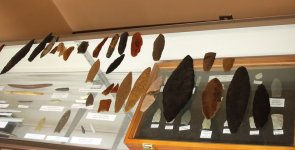
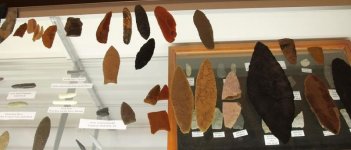
I believe all but one of the late Dr. Stanford's 12 specimens came from the Delmarva/Chesapeake Bay. The one exception was purchased by Hranicky from a Providence, RI collection. It is shown in the photos by Joshua above, but I'm not positive which it is. The illustrations below show this blade that Hranicky found, and purchased, from the Providence, RI collection. It was seen as a Boats Blade, which is one of the forms taken by Transitional Archaic Mansion Inn blades. And it may be a Boats Blade, but I assume Hranicky and Stanford felt otherwise.....
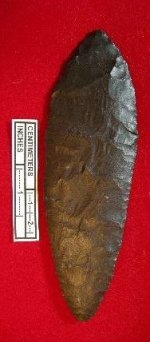
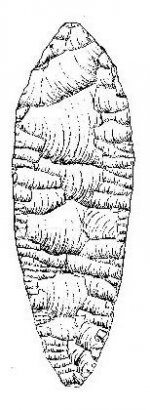
Last edited:
Charl
Silver Member
Now, here is the note Stanford included in "Across Atlantic Ice", which he co-authored with Bruce Bradley. Because Hranicky referenced Bradley and this book, and because the Browning Farm blade was found beneath a colonial chimney, it is small wonder that the Browning Farm specimen would be confused with the first blade said to be made of French flint, and described below by Stanford. Yet, in the description by Hranicky that my friend includes in the long quote in comment #13, Hranicky said it was "found in a trash pit"( I do not have Hranicky's book to check that quote in context). I think of trash pits as the same as refuse pits, those plowed up prehistoric garbage dumps common in some of my fields. Which confuses me, since I don't know how a colonist creates his own trash pit beneath a chimney foundation. I guess he could have lived in a temporary shelter, and then built his home above an area that included one of his trash pits.
At any rate, apparently this blade described by Stanford has never been published, or illustrated anywhere. There is roughly a 10 year difference in the discovery of these two questionable context blades. I also want to leave open the possibility that the two blades are actually one and the same, and that Stanford is confused by dates. But, that would mean he would have missed the published report on the Browning Farm site, and since Stanford knew Hranicky, that seems unlikely to me. Also arguing against confusing the two is that Stanford does not mention other colonial artifacts found with the blade, while the Browning Farm report does...
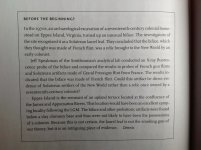
At any rate, apparently this blade described by Stanford has never been published, or illustrated anywhere. There is roughly a 10 year difference in the discovery of these two questionable context blades. I also want to leave open the possibility that the two blades are actually one and the same, and that Stanford is confused by dates. But, that would mean he would have missed the published report on the Browning Farm site, and since Stanford knew Hranicky, that seems unlikely to me. Also arguing against confusing the two is that Stanford does not mention other colonial artifacts found with the blade, while the Browning Farm report does...

Last edited:
Quartzite Keith
Full Member
- Dec 17, 2018
- 179
- 405
- Primary Interest:
- All Treasure Hunting
I believe Stanford did make a couple of mistakes. I believe there was just the one "Solutrean" type point from Virginia. I believe the "trash heap" he mentions was actually "Feature 5" of the site, which was not where the biface was found. The entire report is 20 pages. Below is the first page as description of the site, then each page where the biface is mentioned:
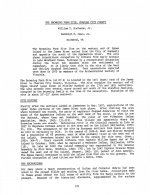
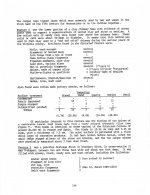
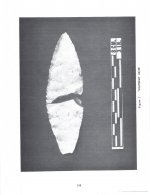
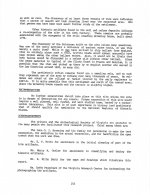




Charl
Silver Member
I believe Stanford did make a couple of mistakes. I believe there was just the one "Solutrean" type point from Virginia. I believe the "trash heap" he mentions was actually "Feature 5" of the site, which was not where the biface was found. The entire report is 20 pages. Below is the first page as description of the site, then each page where the biface is mentioned:
View attachment 1780390
View attachment 1780391
View attachment 1780392
View attachment 1780393
Yeah, after my last comment, and reading both descriptions, including the note by Stanford in Across Atlantic Ice, I really started leaning toward one piece, not two.
Quartzite Keith
Full Member
- Dec 17, 2018
- 179
- 405
- Primary Interest:
- All Treasure Hunting
Not the first time I've ever posted this but while we're on those, I still believe this could be (not positively IS) a USA-Solutrian smoking gun.

Well that's clearly awesome. Where's it from? Any idea on the material?
Top Member Reactions
-
 2576
2576 -
 1142
1142 -
 1044
1044 -
 911
911 -
 893
893 -
 842
842 -
 810
810 -
 701
701 -
 642
642 -
 526
526 -
 494
494 -
 479
479 -
 474
474 -
 470
470 -
 463
463 -
O
441
-
 423
423 -
 392
392 -
 381
381 -
 367
367
Users who are viewing this thread
Total: 2 (members: 0, guests: 2)
